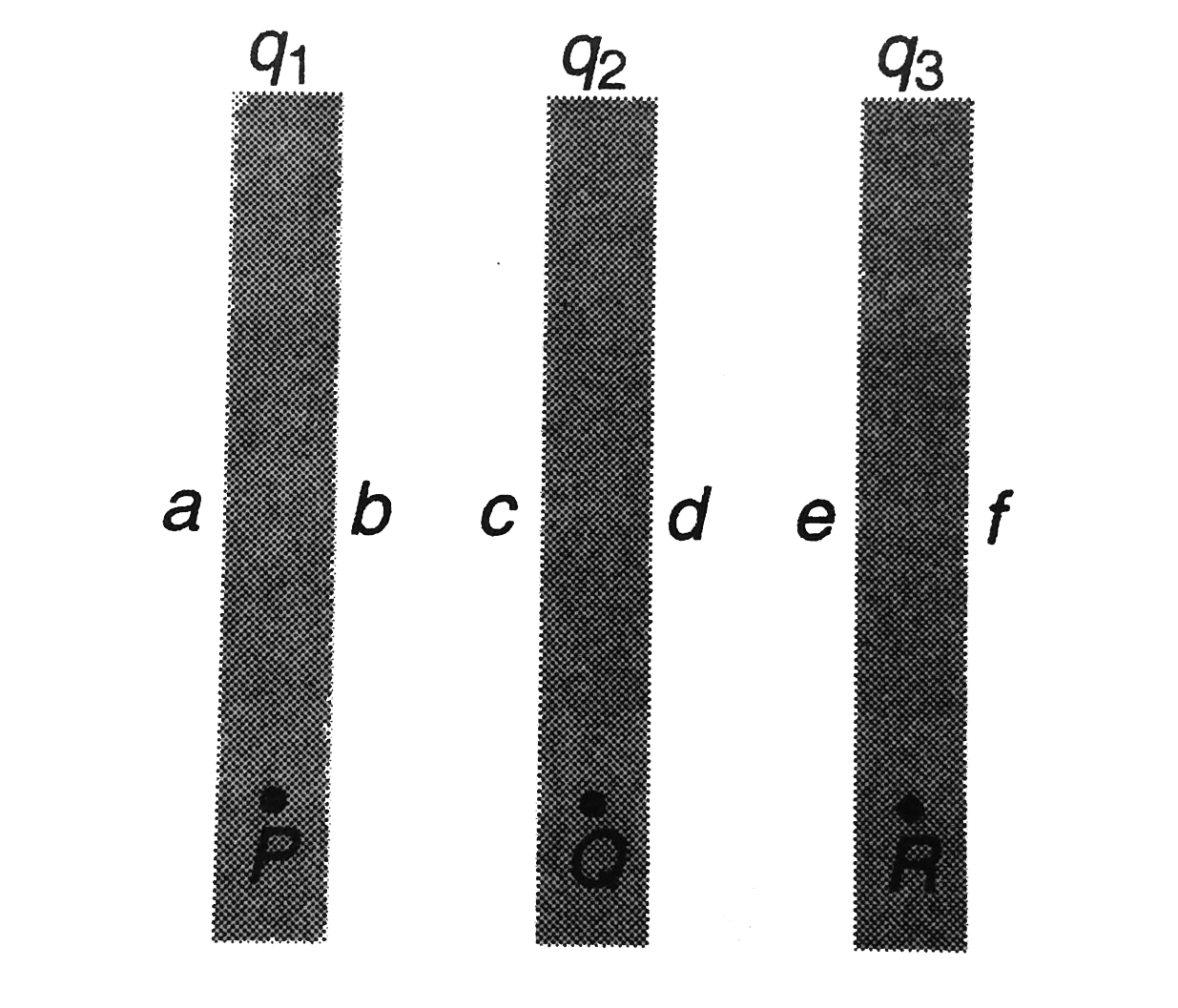Two conducting plates A and B are placed parallel to each other. A is given a charge. Q1 and B a charge Q2. Find the distribution of charges on the four surface.Solution in Gujrati
Consider a Gaussian surface as shown in figure . Two faces of this closed surface lie completely inside the condector where the electric field is zero. The flux through these faced is, therefore, zero. The other parts of the closed surface which are outside the conductor arl parallel to the electric fieeld and hence the electric field through the closed surface is, therefore, zero. From Fauss's law, the total charge inside this closed surface should be zero. The charge on the inner surface of A should be equal and opposite to that on the inner surface of B.
The distribution should be like the one shown in figure (30-W6b). To find the value of q, consider the field at a point P inside the plate A. Suppose, the surface area of the plate (one side) is A. Using the equation E=σ2ε0, the electric field at P
due to the charge Q1−q=Q1−q2Aε0 (downward),
due to the charge +q=q2Aε0 ( upward),
due to the charge −q=q2Aε0 (downward),
and due to the charge Q2+a=Q2+a2Aε (upward).
The net electric field at P due to all the four charged surfaces is ( in the downward direction)
Q1−a2Aε0−q2Aε0+q2Aε0−Q2+q2Aε0.<br>Asthep∮Pis∈stheconduc→r,thisfieldshod––bezer⊙Hence,<br>Q_1-q-Q_2-q=0<br>or,q= Q_-Q_2/2.........(1)<br>Thus,Q_1-q= Q_1=Q_2 /2..........(2)<br>andQ_2+q = Q_1 + Q_2/2.
Using these equation, the distribution shown in the figure (30W6) can be redrawn as in figure (30-W7).
This result is a special case of the following result. When charge conducting plates are placed parallel to each other, the twon outermost surfaces get equal charges and the facing surface get equal nad opposite charges.

Topper's Solved these Questions
- BOOK - HC VERMACHAPTER - GAUSS LAWEXERCISE - Short Answer7videos
GAUSS LAW
- BOOK - HC VERMACHAPTER - GAUSS LAWEXERCISE - Objective 17videos
GAUSS LAW
- BOOK - HC VERMACHAPTER - GAUSS LAWEXERCISE - Exercises24videos
GAUSS LAW
- BOOK - HC VERMACHAPTER - ELECTROMAGNETIC WAVESEXERCISE - Exercises9videos
ELECTROMAGNETIC WAVES
- BOOK - HC VERMACHAPTER - GEOMETRICAL OPTICSEXERCISE - Exercises77videos
GEOMETRICAL OPTICS
Similar Questions
A small plane area is rotated in an electric field. In which orientation of the area is the flux of electric field through the area maximum? In which orientation is it zero.?
08:23View SolutionA charge Q is uniformly distributed over a large plastic plate. The electric field at a point P close to the centre of the plate is 10Vm−1. If the plastic plate is replaced by a copper plate of the same geometrical dimension and carryin the same charge Q1 the electric field at the point P will become
03:24View SolutionThe electric field in a region is given by →E=35E0→i+45E0→j with E0=2.0×103NC−1. Find the flux of this field through a recatngular surface of area 0.2m2 parallel to the y-z plane.
06:31View SolutionShow that the dimensions of the displacement current (ε0dΦEdt) are that of an electric current.
02:20View SolutionA concave mirror having a radius of curvature 40 cm is placed in front of an illuminated point source at a distance of 30 cm from it. Find the location of the image.
03:37View SolutionTwo conducting plates A and B are placed parallel to each other. A is given a charge. Q1 and B a charge Q2. Find the distribution of charges on the four surface.
View SolutionSuppose a charge +Q1 is given to the positive plates and a charge −Q2 to the negative plate of a capacitor. What is the "charge on the capacitor"?
03:13View SolutionThree parallel metalic plates each of area A are kept as shown in figure and charges q1,q2 and q3 are given to them. Find the resulting charge distribution on the six surfaces, neglecting edge effects as usual,
 View Solution
View SolutionIf an isolated infinite plate contains a charge Q1 on one of its surfaces and a charge Q2 on its other surface, then prove that electric field intensity at a point in front of the plate will be Q/2Aε0, where Q=Q1+Q2
03:14View SolutionTwo conducting plates A and B are placed parallel to each other. A is given a charge Q_1 and B a charge Q_2 . Prove that the charges on the inner surfaces are of equal magnitude and opposite sign.
05:30View SolutionTwo conducting plates M and N, each having large surface area A (on one side), are placed parallel to each other in figure. The plate M is given charge Q_1 and N, charge Q_2(ltQ_1) . Then
02:54View SolutionThree large plates A, B and C are placed parallel to each other and charges are given as shown. The charge that appears on the left surface of plate B is
03:21View SolutionTwo identical metal plates are positively charged to Q_1" and " Q_2(Q_2 lt Q_1) . If they are brough near each other to form a parallel plate capacitor of capacitance C, then what will be the potential differences between the plates?
07:20View SolutionC1 तथा C2 धारिता के दो संधारित्रों के समांतर संयोजन को Q आवेश दिया जाता है C1 पर Q1 ,C2 पर Q2 आवेश होने पर Q1Q2 का अनुपात होगा---
02:27View Solutionदो एक जैसी धात्विक प्लेटों को क्रमशः q1 और q2 आवेश (q2<q1) दिया गया है। यदि ये दोनों प्लेटें आपस में पास लाकर एक समान्तर प्लेट संधारित्र की धारिता C है, बनाया जाये, तो इन प्लेटों के मध्य विभवान्तर ज्ञात कीजिए।
03:04View SolutionTwo conducting plates A and B are placed parallel to each other. A is given a charge. Q1 and B a charge Q2. Find the distribution of charges on the four surface.
08:03View Solution

